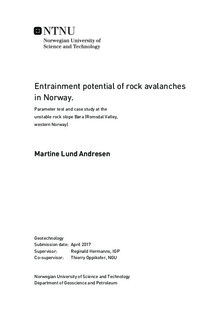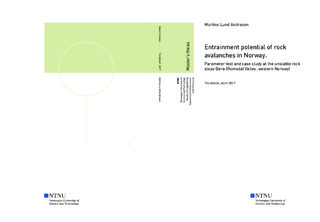| dc.description.abstract | Rock avalanches are frequently reported to entrain significant volumes of debris on their travel path. However, little is known about the debris entrainment potential in Norway. This thesis aims to evaluate and better understand the debris entrainment potential of Norwegian rock avalanches and to study how the run-out is affected by entrainment of debris. Numerical run-out modelling of the unstable rock slope Børa, Romsdal Valley, western Norway is performed to evaluate the mentioned topics.
A sensitivity analysis is carried out in order to determine reasonable input parameters for numerical run-out modelling in DAN3D and to assess the run-outs sensitivity to the different input parameters. The analyses are carried out on three scenarios of different volumes; Børa C (76 000 m3), Børa C Large (476 000 m3) and Børa B (2 400 000 m3). The Voellmy rheology with friction coefficient µ = 0.15 and turbulence coefficient ξ = 500 m/s2 are considered appropriate parameters for the scenarios at Børa, and are applied as a reference. The run-out is sensitive to the friction coefficient µ and the friction angle φb (frictional model), showing decreasing run-outs for increasing values. In addition, the run-out of the larger volumes are slightly sensitive to changes in the turbulence coefficient ξ. None of the remaining input parameters in DAN3D are found to affect modelled run-out distance.
Scenario Børa C is used for the purpose of assessing the entrainment potential. Entrainment of unsaturated material decreases the run-out distance. However, entrainment of completely unsaturated material is not considered realistic at Børa. The opposite is observed for saturated material, showing increasing run-out for increasing pore pressure. In addition, the run-out is highly sensitive to the input friction angle φb, indicating that the properties of the debris are of great importance when parameters are determined. Further analyses shows that entrainment of material (with pore pressure) from lower parts of the slope provides longer run-outs and larger final volumes compared to entrainment from the upper part.
Entrainment in DAN3D is controlled by a user defined entrainment rate, E. The parameter is difficult to assess. Mainly because the expected final volume is required as input. This is extremely difficult to assess, especially in a forward analysis. At Børa, the modelled final volume does not equal the expected final volume. The results indicate that the input final volume should be increased by a factor of one to obtain expected final volumes when modelling, but further analyses are required to state this. Based on the results of this thesis, it is suggested that perhaps DAN3D will not constitute the best tool when a forward analysis of an entrainment event is to be carried out. | |

